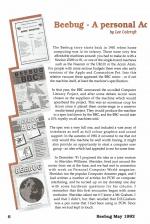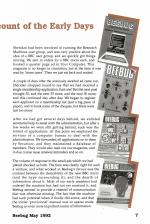
Beebug
 1st May 1992
1st May 1992
Author: Lee Calcraft
Published in Beebug Volume 11 Number 1
Beebug: A Personal Account Of The Early Days
The Beebug story starts back in 1981 when home computing was in its infancy. There were very few affordable machines around: you had to make do with a Sinclair ZX80 or 81, or one of the single-board machines such as the Nascom or the UK101 or the Acorn Atom. For people with more serious budgets there were also early versions of the Apple and Commodore Pet. Into this relative vacuum there appeared the BBC micro - or if not the machine itself, at least the machine's specification. In that year, the BBC announced the so-called Computer Literacy Project, and after some debate Acorn were chosen as the suppliers of the machine which would spearhead the project. This was an enormous coup for Acorn since it placed them centre-stage in a massive media-based project. They would produce the machine to a spec laid down by the BBC, and the BBC would take a 10% royalty on all machines sold.
The spec was a very full one, and included a vast array of interfaces as well as full colour graphics and sound support. In the autumn of 1981 it occurred to me that not only would this machine be well worth having, it might also provide an opportunity to start a computer user group - an idea which had appealed to me for some time.
In December '81 I proposed the idea as a joint venture to Sheridan Williams. Sheridan lived just around the corner from me at the time, and we had met in connection with work on Personal Computer World magazine. Sheridan ran the popular Computer Answers pages, and I had written a number of articles for PCW on computer interfacing, and he turned up on my doorstep one day with some hardware questions for his column. I remember that this first encounter began with some confusion. Sheridan asked me if I knew a Mr Graham. I said that I didn't, but then recalled that D. E. Graham was a pen name that I had been using in PCW. Since then we had kept in touch.
Sheridan had been involved in running the Research Machines user group, and was very positive about the idea of a BBC user group, and we quickly got things moving. We sent in orders for a BBC micro each, and booked a quarter page ad in Your Computer. This magazine is no longer in circulation, but at the time it was read by 'home users'. Then we just sat back and waited.
A couple of days after the anxiously-awaited ad came out, Sheridan dropped round to say that we had received a single membership application. Just one! But the next post brought 30, and the next 30 more, and the next 30 more; and this continued day after day. We began to register each applicant on a membership list (just a big piece of paper), and to bank some of the cheques, but there were just too many.
After we had got several days behind, we enlisted secretarial help to assist with the administration, but after a few weeks we were still getting behind, such was the torrent of applications. At this point we employed the services of a computer bureau to deal with the administration. We forwarded all applications on to them by Securicor, and they maintained a database of members. They would also mail out our magazine, and in due course issue renewal reminders and so on.
The volume of response to the small ads which we had placed shocked us both. The time was clearly right for such a venture, and what worked in Beebug's favour was the contrast between the desirability of the new BBC micro (and the hype surrounding it), and the dearth of information about it. Most of our early members had ordered the machine but had not yet received it, and Beebug seemed to provide a channel of communication that was otherwise missing. The fact that the machine had such potential when it finally did arrive, and that the initial 'provisional' manual was so sparse made Beebug an even more important source of information.
But the lateness of the machine also caused us a problem. Our promotional material was based on a projected first issue of our magazine in April 82, but by late March we had still not received our own BBC Micros. We were rescued from a potentially disastrous situation by the Mehta brothers who run Technomatic. Like other prominent computer dealers, they had been sent early BBC machines for demonstration purposes, and they were kind enough to lend us one for a couple of days. All the articles in the first issue of Beebug were created using this machine in just two or three days of frenetic activity, with the machine shuffling between my house and Sheridan's.
Sheridan entered all the text for this and many subsequent issues into a text editor on his trusty RML 380Z - a machine which actually had disc drives! - and we pasted the whole lot together and handed it to a bemused man at the counter of a local copy shop. Within a few days they shipped the finished magazine to the computer bureau, and some 2000 members received the first issue of Beebug magazine. After breathing a sigh of relief, Sheridan and I sat down to plan the May issue. We had created a kind of monster who required feeding vast quantities of programs, hints, news and other articles on a regular basis, for the forseeable future.
Both Sheridan and I were lecturers - he at Hendon College, and I at Hatfield Polytechnic; and running two full time jobs created a lot of pressure. But it was very rewarding work. Membership continued to grow - by the time that the fourth issue went to press we already had well over 7000 members, and we were getting very positive feedback from the membership. As the year went by we enlisted friends (and relatives) to help with editing, and by the end of the year we had secured some premises, and had employed a part-time editor, as well as a full time technical assistant.
That autumn we branched into software sales, and these proved a very useful addition to revenue. In 1983 my brother Adrian joined the company as software manager, and Mike Williams (no relation to Sheridan) as editor, and as you will know they are still with the company. In 1984 I quit my day job, and Sheridan followed suit a year or so later.
As the years went by the company grew, employing some 25 or 30 people at its zenith, with Beebug attaining a membership of close to 30000. In the summer of 1985 the company moved from its small suite of offices in Marlborough Road, St Albans to new premises at Dolphin Place, St Albans, which also housed a showroom.
In May '86 I reduced my shareholding in the company, and my brother Adrian took up the administrative reins, running the company jointly with Sheridan. This was something of a relief for me as it meant that I could get on and do some computing - as the company had grown over the years, so the amount of hands-on computing that I had time for went down and down. Under the new management the company has continued to do well, bringing out RISC User magazine in response to the launch of the Archimedes in July 1987, and moving into even larger premises in Hatfield Road, St Albans in August 1989. Here's to the next ten years!
This article was converted to a web page from the following pages of Beebug Volume 11 Number 1.




